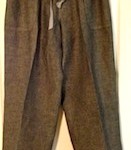Category:how to sew’
Sewing On Buttons
- by admin
Sewing on buttons can be a challenge for many, especially for someone who does not know how to sew.
Recently, I met a client for consultation at a local fabric store to shop for buttons. He had just purchased a 3-piece suit, and the original buttons did nothing for it. The client wanted the suit to stand out.
Buttons dyed to match RTW
 The buttons were apparently dyed to match the suit fabric, and if you looked at the jacket and vest from a distance, you could not tell the buttons were even there. In your mind, you know the buttons are there to close the front of the jacket, but they blend in so well, they’re not noticeable.
The buttons were apparently dyed to match the suit fabric, and if you looked at the jacket and vest from a distance, you could not tell the buttons were even there. In your mind, you know the buttons are there to close the front of the jacket, but they blend in so well, they’re not noticeable.
Sometimes that works out great for a black or brown suit; this suit was cream, with more of a gold tone, and it needed a little something to make it stand out. You know what I mean, don’t you? Something to make you notice it was there.
 Sewing on buttons is not just for replacing loose or lost buttons. Learning how to sew on buttons is also vital to changing the overall appearance of an entire outfit.
Sewing on buttons is not just for replacing loose or lost buttons. Learning how to sew on buttons is also vital to changing the overall appearance of an entire outfit.
Sewing on buttons as a business
And, if you look at it from a business perspective, it can be very profitable when the skill is developed. The cost to service the client can be a little pricey for some. The total cost for supplies and service is $176.40 plus tax. The break down is below:
The new buttons:
$15.50 14- 5/8” for the vest and pants, 1.10/ea.
+9.00 6 -7/8″ for the jacket, 1.50/ea.
+2.00 1 spool matching thread
Total $26.40
Service cost:
$75.00 – 1 hour consultation shopping for buttons, expert advice
+ 75.00 – 1 hour remove old buttons and replace with new buttons
Total $150.00
As you can see, learning how to sew on buttons alone, can be a very profitable business.
However, if the person invested in a class to learn how to sew on buttons, he would save $75.00, then, later use the skill to replace the buttons on another suit himself, he would save $150.00.
Which would you do: invest the time and money upfront to learn how to sew on a button or continue paying someone to replace them for you?
How to sew on a button video
This 5-minute video will show you step-step how to sew on buttons that are required to complete a garment. The same process can be used to add missing buttons on a ready-to-wear clothing.
Sewing Pants – It’s All in the Fit
- by admin
Sewing pants can be enjoyable and truly very easy. Having said that, most people really feel that pants are the most challenging of all the clothes to sew, mainly because they require the most ideal fit. A significant amount of the fit is structured on the center seam that extends from the front to back, through the core of the body, known as the crotch. Until the crotch is in the proper position, no amount of correction made later on can get over a terrible fit.
The length of the crotch really controls the basis of the pants. The basis of a pant includes the area from the waistline to the crotch. Some sewers are terrified by the crotch seam, but the crotch seam on a pair of pants is also very easy to sew. The key to obtaining a very good fit in pants is to choose a design for your pants very carefully. Pants are not complicated to make, but can be challenging to fit mainly because of the never-ending variations in body shapes that result in the need for modifications. If the pants are to fit comfortably and hang properly on the body, then body measurements need to be taken with caution and accuracy.
You really should choose the style of pants ideal for your figure type. If you have heavy upper thighs, pants that are wider and straight-legged from the hips all the way down are a very good choice mainly because they will not cling or highlight the thighs. If you have a boyish figure, meaning your waist is larger than your hips, choose a pattern styled with a narrow waistband and slightly flared legs. If your figure is curvy, keep away from side zippers. The length of your pants is necessary to your overall look.
Select your pants pattern by waistline measurement unless of course your hip measurement is larger than your waistline measurement. If so, choose your pattern size by the hip measurement and alter the waistline. Purchasing a pattern by the accurate hip measurement will keep pattern alterations to a minimum. Although this kind of correct fitting can take a great deal of time and work in the beginning, you will be rewarded with a great-fitting pair of pants that you can duplicate over and over again. You will need to do the major adjustments first.
Again, the most difficult section of sewing pants is the crotch seam, but can be mastered by beginning sewers as well. The crotch length will need to be your body measurement plus 1/2″ for sitting down ease. If not, it should be altered by lengthening or shortening the pattern pieces on the front and back leg pattern adjustment lines. You can obtain much more comprehensive information and facts in regular sewing publications that incorporate guidelines on how to sew pants.
When considering the purchase of regular sewing publications, the litmus test should be a section on sewing pants. If they do not include instructions about sewing pants, they should be placed back on the shelf for someone else to consider. I have discovered through the years that making pants for adults is different than sewing pants for young children. Not many hips and curves to deal with when sewing for children. Appropriate fit is extremely crucial for adults and pants are just one of the most challenging items to fit properly, so it could possibly be smart to do a little homework on obtaining proper fit for adults when sewing pants.
After your pants are cut-out based on your modified pattern, and markings transferred, be certain to follow your pattern’s Sewing Guide thoroughly. On the other hand, not all instructions show pants made in the exact same way. Usually, the crotch area is stitched following the leg seams so that it will not bunch or bind . The simplest way to sew pants is to stitch the two pants legs: stitching the inner leg seam and the side seam for each leg of the pants or shorts. You will have two separate pants legs. Then, insert one leg inside the other, right sides together, matching inner leg seam and stitch the crotch (center) seam. Sewing pants in this sequence also makes it possible for you to get that sturdy crotch seam.
Who knows, if you have a skill for sewing pants for hard-to fit bodies, this may possibly motivate you to sew pants for a living, or to supplement your income in these tough financial moments. It appears that we universally wrestle the most with professional-looking and formal pants that fit. and there are plenty of pattern designs to choose from to get started.
How to Sew Clothes – Freedom to Make What You Want
- by admin
The desire to learn how to sew clothes is reaching an all-time high. Whether it’s because of shows like Project Runway and the Fashion Show inspiring dreams of creativity to design clothes, or just the ability to mend a favorite garment; many individuals have expressed they want to learn how to sew their own clothes. You may have heard other reasons such as the need to sew a button back on that came off doing laundry, that it’s too expensive to have alterations done, too difficult finding clothes that fit a tall, skinny body or it’s just looks like a fun thing to learn how to do.
There are a variety of tools online and off line to assist with the process of learning how to sew clothes. Many start with step-by-step sewing ebooks, videos and or attend classroom sewing courses. I was fortunate enough to start sewing as a child; my mother taught me, and her mother taught her. Sewing was a natural part of life then, a lifeskill. I was so fascinated with the art of creating something with my own hands, that I, later majored in Home Economics Education and taught other young men and women to do the same.
I was one of those persons that fit in the tall, skinny category, and could never find anything to fit my body. If I found a blouse to fit my torso, it was not close to covering the length of my arms, unless it was sleeveless and summertime. Now, as I remember, summertime was probably my favorite time of the year for buying clothes that fit; less skin to cover. But, once spring or summer was over, I had a variety of challenges.
I was forced to learn how to sew clothes simply because I could not find anything to wear in the wintertime. My ready-to-wear pants were always too short and my sleeves were never long enough to keep the chill off my long skinny arms and legs. Unfortunately, I am faced with a slightly different problem today. Now that my body has matured, I need to add a little more width to cover my long legs and arms. Either way, knowing how to sew my own clothes has been a godsend. And knowing how to sew clothes that fit my body has been even better.
If nothing in the ready-to-wear arena fits my body the way I like it, nor comes in the color that complements my skin tone, or fits my budget, I always have another option. I am never concerned anymore about stepping into a room full of people, on a very special occasion and spotting someone across the room in the exact, same outfit that I have on. This causes me to wonder if the people in the room are thinking that the other person looks better in their outfit, than I do in mine. Thank goodness, some people are kind enough not to say anything, but you think they are talking with their eyes. It sort of ruins the evening, if you let it. Next time, you say to yourself, I’ll sew it myself and I will not have this problem.
I understand the desire or need to learn how to sew clothes, especially clothes that fit your body; the frustration of realizing that your body has changed and you don’t have anything to wear, again. I know the problems you are faced with when shopping store-to-store and leaving empty-handed.
But, I also know the overwhelming joy that I feel walking out of the fabric store visualizing how I will look in my new, one-of-a-kind outfit.





